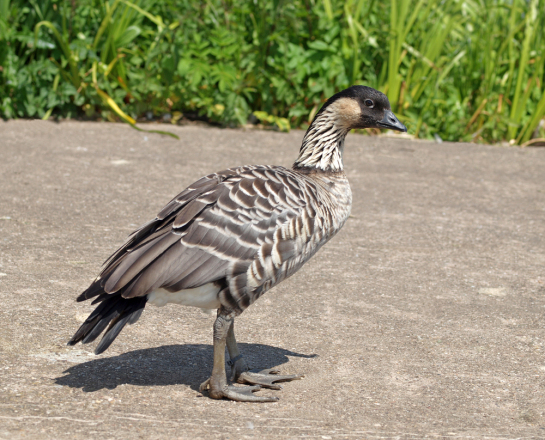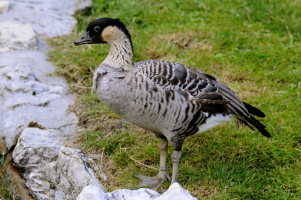
When someone mentions geese, or you hear that oh so familiar call from overhead, odds are you probably picture a Canada Goose in your mind. If you live in Hawaii, however, you might picture a Nene, or Hawaiian Goose(Branta sandvicensis). Hawaiian Geese are only found in Hawaii, which on its own is a rather small collection of islands. Here’s everything you need to know about Hawaiian Geese.

Hawaiian Geese, or Nenes as they are sometimes called, are medium sized birds that spend most of their time on the ground. Males have black on their head and hindneck as well as black and white diagonal stripes that make them stand out against other species of geese. You can find the Hawaiian Goose right at home in shrubland, grassland, coastal dunes, and even lava plains. At one point you could spot them on seven Hawaiian islands, but now their range is limited to just four. Just like their cousin the Canada Goose, Hawaiian Geese will often choose a golf course for their home because of how similar the terrain is to what they’re used to.

| Length | 63-69 cm(2’0.8″-2’3.2″) |
| Wingspan | 1-1.1 m(3’3.4″-3’7.3″) |
| Weight | 1.32-3.1 kg(2.91-6.83 lbs.) |
When it comes to food, Hawaiian Geese are resourceful creatures that will either browse or graze depending on what is available to them. They’re herbivores, so meals are usually made up of leaves, seeds, fruit, shrubs, and flowers that grow on grasses. Even though goslings are good at finding things like this to eat on their own, they stay with their parents until the next breeding season, which lasts from August to April. This is where Hawaiian Geese really stand out from their cousins; their breeding season is longer than that of any other goose and, unlike most waterfowl, they prefer to mate on land. Female Hawaiian Geese are in charge when it comes to picking the place to set up a nest, and they do most of the building as well, while the male stands guard, of course.

Unfortunately, the Hawaiian Goose is the rarest species of goose, with only around 2,500 geese living in Hawaii. When Captain James Cook arrived to the islands in 1778, there were over 25,000 Hawaiian Geese calling the place home, but hunting and new predators quickly cut the population down to roughly 30 by the 1950s. Luckily, Hawaiian Geese were successfully re-introduced to the island since then and the population has continued to grow to today. Keep an eye out next time you visit these gorgeous islands, you might spot one for yourself!
Conservation Status
The Hawaiian Goose is listed as near threatened,
